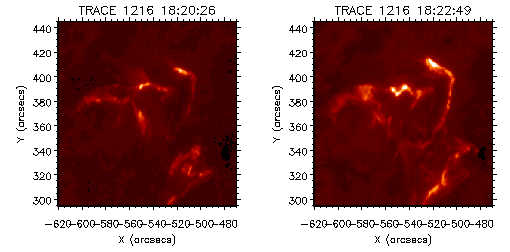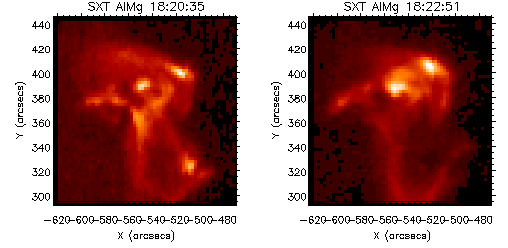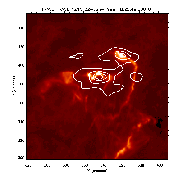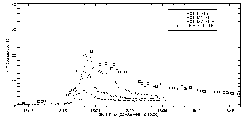A Knotty Flare
Science Nugget: March 10, 2000
Introduction
In the absence of anything particularly spectacular in this week's observations
with Yohkoh, we will do a little preparation for next week's big event.
Next week Yohkoh will participate in Max
Millenium Observing Campaign number 6, the prime goal of which is to
secure observations of flare signatures coming from low down in the solar
atmosphere. While SXT most often shows us the hot coronal loops formed
during and after solar flares, other instruments observing at different
wavelengths, are particularly good at illustrating where and how the solar
chromosphere and transition region responds to the onslaught of heat and
particles generated by a flare. This in turn may help us to identify what
parts of the overall flaring structure are the first to be disrupted, and
where the major energy release takes place.
A Good Example from the Archives: Jun 22 1999
On Jun 22 1999, Yohkoh SXT and TRACE
were
both observing a flaring active region, and by great good fortune, TRACE
was making high-cadence images in the Lyman alpha line (1216A). Lyman alpha
emission, from neutral hydrogen, comes from the chromosphere, where the
temperature is 10,000 - 20,000K.
The flare was a complicated-looking beast. The Lyman alpha observations
at the maximum of the flare impulsive phase (18:21 - 18:23 UT) show two
bright knots of emission and a flare ribbon

These same features, notably the two bright knots, show up in the SXT
images at the same time, which is a bit weird perhaps, since we are used
to SXT showing us large fuzzy loops. (K)Not in this case! What SXT might
be showing here is the location of strong heating of the lower atmosphere,
maybe by particle beams. Or perhaps the knots are in fact two very tiny
hot loops?

Relationship to Hard X-ray emission
We think that we understand that hard X-ray (HXR) emission, as detected
by the Hard X-ray Telescope (HXT) on Yohkoh, is generated by high energy
electrons, accelerated in the flare, when they hit the the `brick wall'
of the chromosphere. So the location of HXR emission tells us where these
electron beams arrive, and we can possibly also deduce where they came
from.
 (click on image
for a full-size version)
(click on image
for a full-size version)
We find that the HXR emission is again concentrated into two bright
knots, and overlaying contours of HXR emission on top of a Lyman alpha
image from the same time, we find that these line up with the two bright
Lyman knots. This suggests very strongly that the Lyman alpha emission
has something to do with electron beams - maybe electron beams heat up
a cooler part of the atmosphere so that it radiates in Lyman alpha, or
maybe they collisionally excite hydrogen atoms.
So is flare electron acceleration taking place somewhere in the corona
in between these two knots? Are these the only places that accelerated
electrons are reaching the chromosphere? Could it be that more of the Lyman
alpha emission is caused by electron beams, in which case the TRACE images
might tell us more about flare particle acceleration than we can see from
HXT images alone? Questions, questions...
The following image, courtesy of Harry Warren (who alerted the author
to this event), shows how the HXR light curve and the Lyman alpha light
curves compare.
 (click on the thumbnail for a full-size image.)
(click on the thumbnail for a full-size image.)
Although the time resolution of the Lyman alpha curve is not very good,
we can see some interesing things. The Lyman alpha and HXR emission peaks
at roughly the same time, and the little bumps in the Lyman alpha light
curve and in the HXR light curves line up fairly well. But the Lyman alpha
emission has started to rise before the HXRs really get going. So it's
possible that the Lyman alpha emission is caused by something other than
electron beam bombardment, or maybe early in the flare the bombardment
just isn't strong enough to generate visible hard X-rays.
What will next week's observations add to this?
Next we will be running TRACE sequences designed to look at the chromospheric
signatures of flares at a much higher cadence than the observations shown
here - we estimate we can make TRACE images once every 4 seconds. This
will enable us to make a better comparison to the time evolution of the
HXR and soft X-ray signatures. Furthermore, we will be searching for another
type of chromospheric signal - H alpha linear polarization, which is thought
to be generated by low energy protons accelerated in flares. The role of
protons, in flares is little understood, because the low energy ones have
few detectable signatures (H alpha linear polarization is thought to be
one of them) and the radiation from the high energy ones has not yet been
imaged. After next week we hope we will be able to say a little more about
protons, electrons, where they are accelerated and how many of each there
are, in at least one flare.
March 11, 2000
L. Fletcher (fletcher@sag.lmsal.com)



 (click on image
for a full-size version)
(click on image
for a full-size version)
 (click on the thumbnail for a full-size image.)
(click on the thumbnail for a full-size image.)